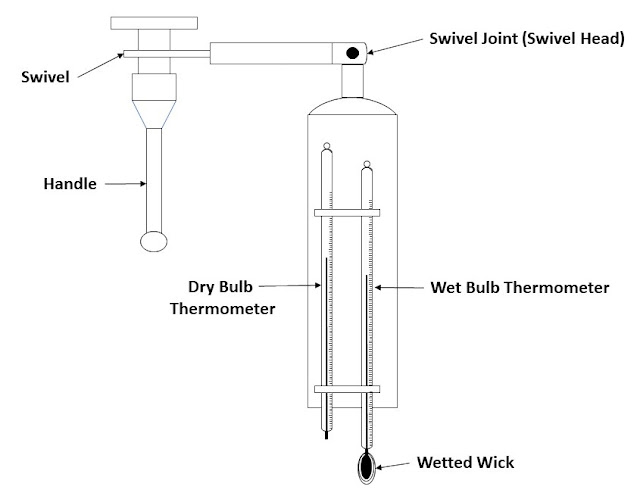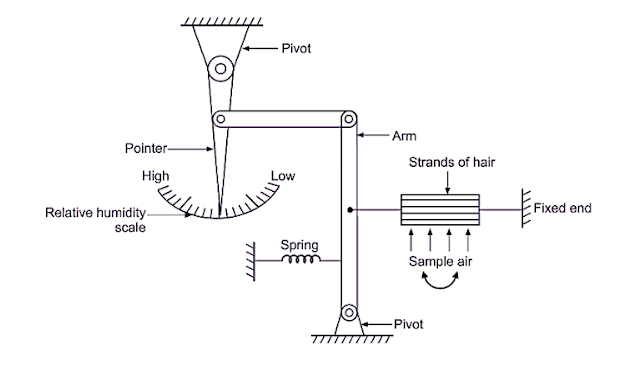Types of Hygrometer
Types of Hygrometer
- Dry & wet bulb hygrometer. (Psychrometer)
- Hair hygrometer
- Sling psychrometer.
- Chilled mirror dew point hygrometer
Dry & wet bulb hygrometer. (Psychrometer)
When water or ice covers the bulb of a thermometer (wet-bulb), latent heat is removed from the surface of the bulb as the water evaporates, and the wet-bulb temperature becomes lower than the air (dry-bulb) temperature.
At a lower humidity, water evaporates more actively, so that the wet-bulb temperature lowers sharply.
The aspirated psychrometer measures humidity by measuring the difference between the dry-bulb temperature and wet-bulb temperature.
A psychrometer, or a wet and dry-bulb thermometer, consists of two calibrated thermometers, one that is dry and one that is kept moist with distilled water on a sock or wick.
At temperatures above the freezing point of water, evaporation of water from the wick lowers the temperature, such that the wet-bulb thermometer will be at a lower temperature than that of the dry-bulb thermometer.
When the air temperature is below freezing, however, the wet-bulb must be covered with a thin coating of ice, in order to be accurate.
As a result of the heat of sublimation, the wet-bulb temperature will eventually be lower than the dry bulb, although this may take many minutes of continued use of the psychrometer.
Wet and dry bulb psychrometers are the most simple and common way of measuring humidity.
This type of hygrometer uses two basic mercury thermometers, one with a wet bulb one with a dry bulb.
Evaporation from the water on the wet bulb causes its temperature reading to drop, causing it to show a lower temperature than the dry bulb.
Relative humidity is calculated by comparing the readings using a calculation table that compares the ambient temperature (the temperature given by the dry bulb) to the difference in temperatures between the two thermometers.
Hair hygrometer
Hair hygrometer are called membrane hygrometer when the sensing element is a membrane.
Hair hygrometer is a type of absorption hygrometer and uses the mechanical humidity sensing technique.
Hair hygrometer is a type of absorption hygrometer, Which works on the principle that, "Change in moisture content causes change in physical and chemical properties of certain materials", Such as, human hair, animal membrane, Wood, Paper etc.. As human hairs are used in this hygrometer, this type is called as hair hygrometer.
Construction
Working of hair hygrometer depends upon the physical changes in human hair i.e. tendency to lengthen, when they absorb moisture and shorten, after losing moisture and getting dry. This absorption depends upon temperature and partial water vapor pressure in atmosphere. Due to this, extension or elongation of hairs is a function of relative humidity
fig shows an arrangement, where expansion and contraction of human hair may be reflected through a mechanical linkage ta an indicating pointer
Human hair is used as the humidity sensor. The hair is arranged in parallel beam and they are separated from one another to expose them to the surrounding air/atmosphere. Number of hairs are placed in parallel to increase mechanical strength.
This hair arrangement is placed under small tension by the use of a tension spring to ensure proper functioning.
The hair arrangement is connected to an arm and a link arrangement and the link is attached to a pointer pivoted at one end. The pointer sweeps over a humidity calibrated scale.
When the humidity of air is to be measured, this air is made to surround the hair arrangement and the hair arrangement absorbs the humidity from the surrounding air and expands or contracts in the linear direction.
This expansion or contraction of the hair arrangement moves the arm & link and thus the pointer to a suitable position on the calibrated scale and thus indicating the humidity present in the air/atmosphere.
Advantages
- Low cost
- Available in pocket size shapes
- No need for precision
- It is useful at room temperature
Disadvantages
- Hair hygrometers are recommended, only when temperature ranges from 0 to 75 degree celsius and relative humidity ranges from 30% to 95%
- Less accuracy(3 to 4%)
- Slow in response
Application
- To measure relative humidity at offices, process plants and air conditioned rooms
- To measure humidity in residences and greenhouses


Comments
Post a Comment